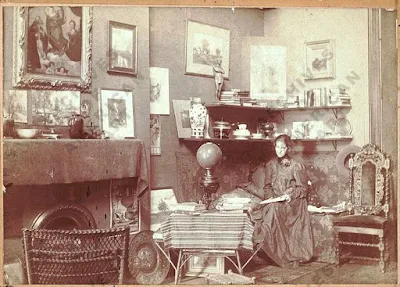Americas Finest: The Red Rose Girls (1863-1935)
Elizabeth Shippen Green, Violet Oakley, Jessie Willcox Smith and Henrietta Cozens in their Chestnut Street studio, 1901.
Photograph shows Green, Oakley, and Smith seated, each holding a rose, while Cozens holds a watering can over their heads, pretending to water them. Identification on verso (handwritten): The red roses; Elizabeth Shippen Green, Violet Oakley, Jessie Willcox Smith, Henrietta Cozens; with Violet Oakley poster [in background] for first exhibition at the Plastic Club; taken at 1523 Chestnut Street, when they planned to move to "The Red Rose", Villanova.
Photograph shows Green, Oakley, and Smith seated, each holding a rose, while Cozens holds a watering can over their heads, pretending to water them. Identification on verso (handwritten): The red roses; Elizabeth Shippen Green, Violet Oakley, Jessie Willcox Smith, Henrietta Cozens; with Violet Oakley poster [in background] for first exhibition at the Plastic Club; taken at 1523 Chestnut Street, when they planned to move to "The Red Rose", Villanova.
THE RED ROSE GIRLS
Three Philadelphia women became successful illustrators for
books and magazines working in a profession largely dominated by men at the
turn of the 20th century: Jessie
Willcox smith (1863-1935) Violet Oakley (1874-1961) and their colleague
Elizabeth Shippen Green (1871-1954). They
forged an unconventional communal relationship based on passion for their art
and love for one another. Under the mentorship of their teacher, the
illustrator Howard Pyle, they earned commissions from the nation’s most
prestigious periodicals, including Collier’s and The Saturday Evening Post. For
instance, Violet Oakley’s paintings now hang in the Pennsylvania state capitol
building. Along with their friend
Henrietta Cozens, they set up a household at Philadelphia’s beautiful Red Rose
inn and called themselves the ‘Cogs family,’ a name formed from the initial
letters of each of their surnames. However, society and the press referred to
them as ‘The Red Rose Girls.’ In their
own individual ways these women were rebels, and their story, often romantic,
yet resolutely stylized illustrations were the epitome of respectability.
Violet Oakley, Jessie Wilcox Smith, Elizabeth Shippen Green, and Henrietta Cozens, 1901
Jessie Willcox Smith and Elizabeth Shippen Green with Prince the dog in the garden at Cogslea. Elizabeth Shippen Green stands in the garden by the fountain, the dog
Prince laying at her feet. Jessie Willcox Smith is stepping through the
garden door. 1901.
I know I shouldn't single just one woman out when all were amazing individually. However, Violet Oakley became known not only as an illustrator but a muralist as well. So for this reason she will be highlighted here.
Violet Oakley standing beside a portion of her 44-foot-wide mural, International Unity and Understanding.
As Violet travelled and studied throughout Amerca and Europe, she painted portraits and landscapes in an impressionistic style. In 1896 her father's illness forced her to concentrate on illustrations solely. The technique she developed as an illustrator grew into the mural style that made her famous.
Violet Oakley's mural painted on the walls of the Governor's Room of the Pennsylvania state Capitol Building
Penn's Vision," by Violet Oakley, Governor's Reception Room in the Pennsylvania State Capitol, Harrisburg, PA.
In the 1910s, Violet Oakley painted forty-three murals in the Governors
Grand Reception Room, the Senate, and the Supreme Court of Pennsylvania
State Capitol Building.
The Holy Experiment by Violet Oakley
A visit to Pennsylvania's Capitol in Harrisburg is not complete without seeing
the famous mural series created by Philadelphia artist Violet Oakley (1874-1961).
The commission to paint these thirteen murals for the Governor's Reception Room,
which was awarded to Oakley in 1902 and completed in 1906, signaled not only her
status as a major Pennsylvania artist but also was a milestone in the history of
American art. It was the largest public commission awarded to a woman in the
United States to that date. With this series, titled The Holy Experiment,
Oakley garnered a gold medal in 1905 from the Pennsylvania Academy of the
Fine Arts, and significant national recognition throughout her career.
Violet Oakley in her studio, 1901
Violet Oakley in her studio at 1523 Chestnut Street. Photograph taken before 1898
I just love this photograph of Elizabeth Shippen Green in her studio at the Red Rose Inn, 1903
Violet Oakley and Henrietta Cozens (ca. 1864-1940). Cozens lived with
the Red Rose Girls and tended to the overall upkeep of the house and
gardens. Oakley and Cozens enjoy a cup of tea together while sitting
on the terrace at Cogslea with the family dog, Prince, seated behind
Cozens.
After leaving the Red Rose Inn the Girls moved into Cogslea, in
Mount Airy on the edge of the Wissahickon section of Fairmount
Park. Based on an acronym of the foursome’s last names, the Girls
liked to refer to themselves as the “Cogs” family. Jessie Wilcox Smith often
photographed her subjects in the surrounding grounds of the estate. Shown in the garden, the subject stands in front of
the pergola next to a fountain (bottom left). The adjacent portrait
captures a glimpse of the Cogslea estate (bottom right).
The Thousand Quilt, 1904, by Elizabeth Shippen Green
Morning, 1902, by Jessie Wilcox Smith
I just wanted to provide a glimpse into the world of three amazingly talented turn of the century American female illustrators and muralist. Photographs taken from American Archives Smithsonian Institution
Feel free to leave comments,














Comments